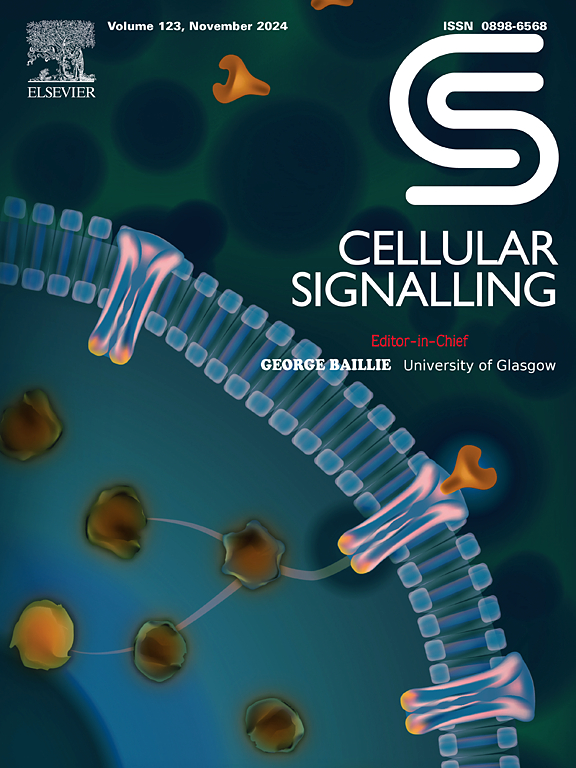阻断psmd14介导的E2F1/ERK/AKT信号通路可抑制间变性甲状腺癌的进展
IF 4.4
2区 生物学
Q2 CELL BIOLOGY
引用次数: 0
摘要
间变性甲状腺癌(ATC)是甲状腺癌中最具侵袭性的亚型,目前尚无有效的治疗策略。最近的研究已经确定去泛素化酶(DUB) 26S蛋白酶体非atp酶调节亚基14 (PSMD14)是多种癌症的有希望的治疗靶点;然而,PSMD14在ATC中的作用在很大程度上仍然未知。本研究中,我们发现PSMD14在ATC组织中表达上调,其异常表达与ATC患者的总生存率呈负相关。在功能上,PSMD14促进ATC细胞的增殖和侵袭性,而PSMD14或PSMD14抑制剂硫素(THL)的缺失抑制ATC细胞的生长、侵袭性和上皮-间质转化(EMT)。此外,psmd14缺失的ATC细胞和THL处理的ATC细胞的细胞周期被阻滞,细胞凋亡增加。体内实验表明,THL对ATC异种移植具有有效的抑制作用。机制上,PSMD14通过结合和去泛素化E2F1来增加E2F1的稳定性。psmd14调控的E2F1改善了ERK和AKT信号通路的激活,这些信号通路在ATC肿瘤发生和进展中起重要作用。总之,我们的研究结果揭示了PSMD14在ATC中的致癌作用,并为ATC的治疗提供了一个有希望的治疗靶点。本文章由计算机程序翻译,如有差异,请以英文原文为准。
Blocking PSMD14-mediated E2F1/ERK/AKT signaling pathways suppresses the progression of anaplastic thyroid cancer
Anaplastic thyroid cancer (ATC) is the most aggressive subtype of thyroid cancer with few effective therapeutic strategies. Recent studies have identified the deubiquitinating enzyme (DUB) 26S proteasome non-ATPase regulatory subunit 14 (PSMD14) as a promising therapeutic target for multiple cancers; however, the role of PSMD14 in ATC remains largely unknown. Here, we found that PSMD14 was upregulated in ATC tissues and that its aberrant expression was negatively associated with the overall survival of patients with ATC. Functionally, PSMD14 promotes the proliferation and invasiveness of ATC cells, whereas the depletion of PSMD14 or PSMD14 inhibitor thiolutin (THL) inhibits the growth, invasiveness, and epithelial-mesenchymal transition ((EMT) of ATC cells. In addition, the cell cycle was arrested and apoptosis was increased in PSMD14-depleted ATC or ATC cells treated with THL in vitro. An in vivo assay indicated that THL exerted a potent inhibitory effect on ATC xenografts. Mechanistically, PSMD14 increased E2F1 stabilization by binding to and deubiquitinating E2F1. PSMD14-regulated E2F1 improved the activation of the ERK and AKT signaling pathways, which are instrumental in ATC tumorigenesis and progression. Overall, our findings reveal the oncogenic role of PSMD14 in ATC and provide a promising therapeutic target for the treatment of ATC.
求助全文
通过发布文献求助,成功后即可免费获取论文全文。
去求助
来源期刊

Cellular signalling
生物-细胞生物学
CiteScore
8.40
自引率
0.00%
发文量
250
审稿时长
27 days
期刊介绍:
Cellular Signalling publishes original research describing fundamental and clinical findings on the mechanisms, actions and structural components of cellular signalling systems in vitro and in vivo.
Cellular Signalling aims at full length research papers defining signalling systems ranging from microorganisms to cells, tissues and higher organisms.
 求助内容:
求助内容: 应助结果提醒方式:
应助结果提醒方式:


